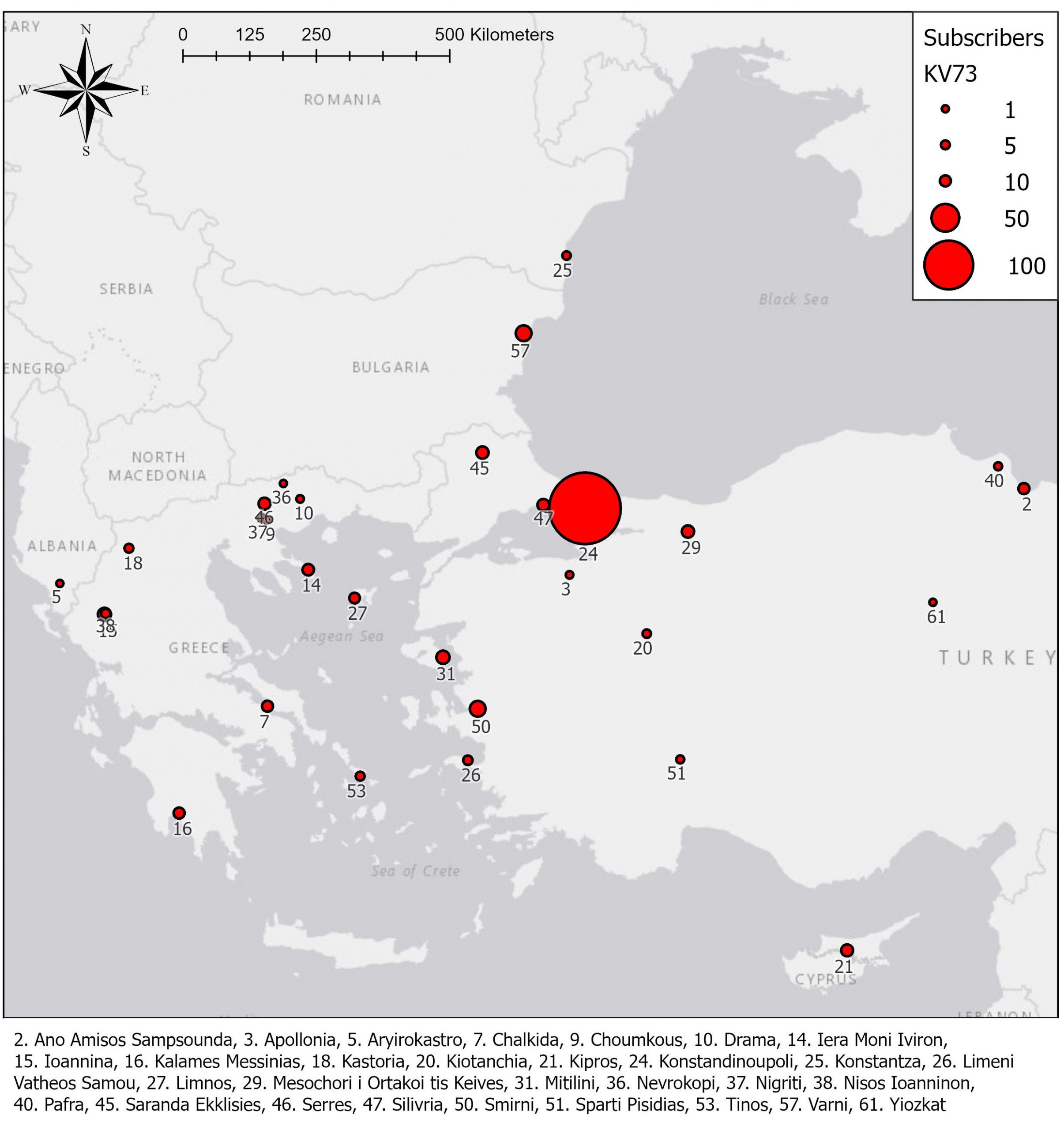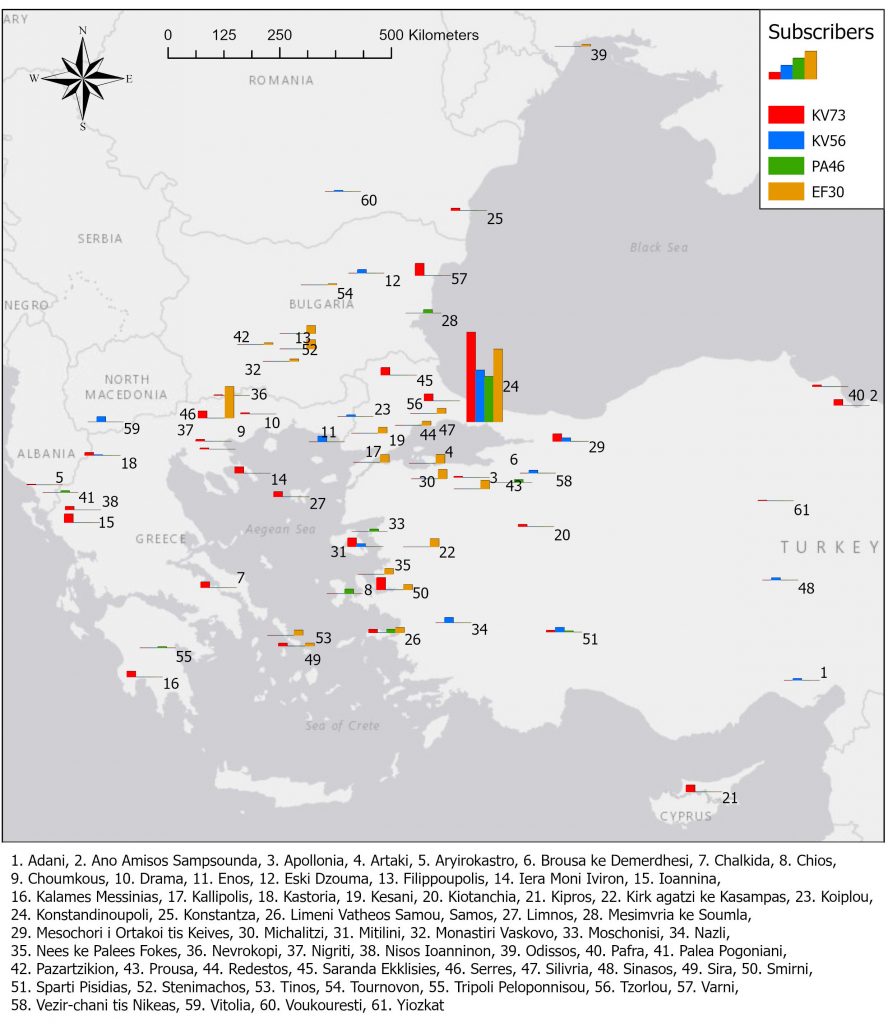The phenomenon of subscription lends significant insights into the study of the social history of printed music collections. The four collections under consideration were published with the method of pre-subscription: A forthcoming publication was announced in the press and subscriptions were invited. In certain cases, such announcements included a detailed account of the author’s aims and motivation, the book contents, and information on the venues were interested parties could pre-subscribe, with the fee being paid usually upon delivery of the book. The published books often contained a subscribers’ catalogue, according the subscribers public visibility and social status and thus further motivation for pre-subscription. Such catalogues, despite their limitations (e.g. their divergent content in different book editions and/or copies), are an important source on the consumption side of the cultural product: who bought the Greek printed music collections? How were the collections used?
The sources for the following chartographic representations are the subscribers’ catalogues of four Greek printed music collections:
| EF30 | Phokaeus, Theodoros, and Staurakis Vyzantios. 1830. Βίβλος καλουμένη Εὐτέρπη περιέχουσα συλλογὴν ἐκ τῶν νεωτέρων καὶ ἡδυτέρων ἐξωτερικῶν μελῶν, μὲ προσθήκην ἐν τῷ τέλει καὶ τινων ρωμαϊκῶν τραγῳδίων εἰς μέλος ὀθωμανικὸν καὶ εὐρωπαϊκόν. Istanbul: Kastor. | The first printed collection of Ottoman vocal pieces recorded in the New Method notation. Some Greek pieces following the Ottoman, or a more western compositional style are included in the end. (Title translation: The book called Euterpi containing a collection of the most modern and beautiful secular pieces, with the addition in the end of some Rum songs having Ottoman and European melody.) |
| PA46 | Phokaeus, Theodoros. 1846. Η Πανδώρα ήτοι συλλογή εκ των νεωτέρων και ηδυτέρων εξωτερικών μελών. Istanbul: Typographeia Kastrou. | A two-volume collection of Greek and Ottoman vocal pieces recorded in the New Method notation. Some of these are included in the previous collection of the editor, called “Euterpi”. (Title translation: Pandora, that is a collection of the most modern and beautiful pieces.) |
| KV56 | Zographos, Ioannis G. (Nikaeus). 1856. Απάνθισμα ή Μεδζμουάι Μακαμάτ, περιέχον μεν διάφορα τουρκικά άσματα. Istanbul: Thaddaios Tivedtsian. | A collection of Ottoman pieces recorded in the New Method notation. Also included in the beginning is a version, in both Turkish and Greek, of Haşim Bey’s essay on the main Ottoman rhythmic patterns (usul). (Title translation: A compilation of various Turkish songs.) |
| KV72 | Zographos, Ioannis G. (Keivelis). 1872. Μουσικόν Απάνθισμα (Μεδζουμάι Μακαμάτ) διαφόρων ασμάτων μελοποιηθέντων παρά διαφόρων μελοποιών. Istanbul: “I Anatoli”, Euangelinos Misailidis. | A two-volume collection of Greek and Ottoman vocal pieces recorded in the New Method notation. Some of these pieces were also included in the previous collection by Zographos. (Title translation: Musical Compilation of various songs composed by various composers.) |
The particular subscribers’ catalogues can be mined for the clues they give with regard to the place of origin and residence, professional occupation, and social title of those enlisted (Table 1), as well as for reconstructing the geographies of distribution and circulation of the collections.


Table 1: A page from the subscribers’ catalogue of KV56 (left) and EF30 (right)
As a general trend, for instance, a substantial portion of the copies are sold in Istanbul, while the geographical distribution appears to widen in the later collections, an indication of the gradual growth of the music book printing networks (Tables 2-6).




Tables 2-5: Geographical distribution of the subscribers of EF30, PA46, KV56, and KV72 respectively
Table 6: Subscribers’ geographical distribution – comparative display of all four collections.
Map compositions by Markos Katsianis.
Read more on the subject:
Kallimopoulou, Eleni. “Greek printed music collections: music typography and music sociality in late-Ottoman Istanbul.” Mousikos Logos. (forthcoming)

